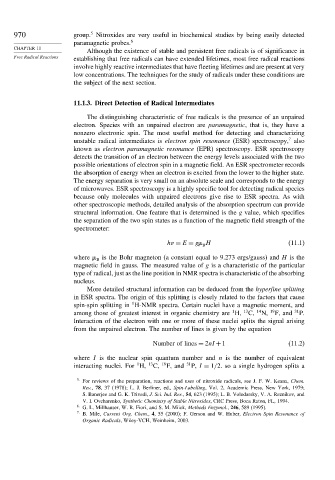Page 986 - Advanced Organic Chemistry Part A - Structure and Mechanisms, 5th ed (2007) - Carey _ Sundberg
P. 986
5
970 group. Nitroxides are very useful in biochemical studies by being easily detected
paramagnetic probes. 6
CHAPTER 11
Although the existence of stable and persistent free radicals is of significance in
Free Radical Reactions establishing that free radicals can have extended lifetimes, most free radical reactions
involve highly reactive intermediates that have fleeting lifetimes and are present at very
low concentrations. The techniques for the study of radicals under these conditions are
the subject of the next section.
11.1.3. Direct Detection of Radical Intermediates
The distinguishing characteristic of free radicals is the presence of an unpaired
electron. Species with an unpaired electron are paramagnetic, that is, they have a
nonzero electronic spin. The most useful method for detecting and characterizing
7
unstable radical intermediates is electron spin resonance (ESR) spectroscopy, also
known as electron paramagnetic resonance (EPR) spectroscopy. ESR spectroscopy
detects the transition of an electron between the energy levels associated with the two
possible orientations of electron spin in a magnetic field. An ESR spectrometer records
the absorption of energy when an electron is excited from the lower to the higher state.
The energy separation is very small on an absolute scale and corresponds to the energy
of microwaves. ESR spectroscopy is a highly specific tool for detecting radical species
because only molecules with unpaired electrons give rise to ESR spectra. As with
other spectroscopic methods, detailed analysis of the absorption spectrum can provide
structural information. One feature that is determined is the g value, which specifies
the separation of the two spin states as a function of the magnetic field strength of the
spectrometer:
h = E = g H (11.1)
B
where is the Bohr magneton (a constant equal to 9.273 ergs/gauss) and H is the
B
magnetic field in gauss. The measured value of g is a characteristic of the particular
type of radical, just as the line position in NMR spectra is characteristic of the absorbing
nucleus.
More detailed structural information can be deduced from the hyperfine splitting
in ESR spectra. The origin of this splitting is closely related to the factors that cause
1
spin-spin splitting in H-NMR spectra. Certain nuclei have a magnetic moment, and
1
among those of greatest interest in organic chemistry are H, 13 C, 14 N, 19 F, and 31 P.
Interaction of the electron with one or more of these nuclei splits the signal arising
from the unpaired electron. The number of lines is given by the equation
Number of lines = 2nI +1 (11.2)
where I is the nuclear spin quantum number and n is the number of equivalent
1
interacting nuclei. For H, 13 C, 19 F, and 31 P, I = 1/2. so a single hydrogen splits a
5
For reviews of the preparation, reactions and uses of nitroxide radicals, see J. F. W. Keana, Chem.
Rev., 78, 37 (1978); L. J. Berliner, ed., Spin-Labelling, Vol. 2, Academic Press, New York, 1979;
S. Banerjee and G. K. Trivedi, J. Sci. Ind. Res., 54, 623 (1995); L. B. Volodarsky, V. A. Reznikov, and
V. I. Ovcharenko, Synthetic Chemistry of Stable Nitroxides, CRC Press, Boca Raton, FL, 1994.
6 G. L. Millhauser, W. R. Fiori, and S. M. Miick, Methods Enzymol., 246, 589 (1995).
7
B. Mile, Current Org. Chem., 4, 55 (2000); F. Gerson and W. Huber, Electron Spin Resonance of
Organic Radicals, Wiley-VCH, Weinheim, 2003.

